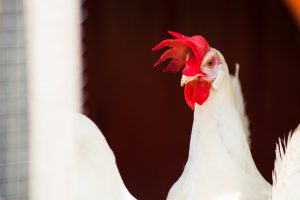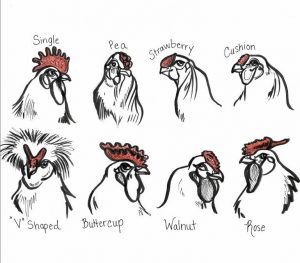Why do chickens have combs?
Despite being iconic to the look of a chicken, combs actually serve a very important purpose. Besides being attractive to the opposite sex, combs are important heat regulators. Chickens are unable to sweat. Heat radiates out of their combs and wattles, thus keeping them cool.
As we know, roosters are the showmen of the poultry world. Long shiny feathers, huge combs, a sharp spurs, they are certainly lookers!
A rooster will have a larger, redder comb due his influx of hormones. This helps him look impressive to his ladies. In addition, studies has shown that wild game fowl hens with large red combs are easier to see, thus resulting in roosters mating with them more.

Why do they vary?
There are many different types of combs, many specific to certain breeds. Just as each breed has a particular shape, feather patterning, and disposition, they also have specific combs.
The most common type of comb is the single comb. It consists of a stiff single lobe, with 4-6 tips at the top.
Another common comb is the pea comb. Most commonly seen in colored egg layers, a pea comb is tiny and looks like a row of tiny red peas perched in the middle of the head.
Rose combs are also common, and seen mainly in Wyandottes. The bumpy cluster of red lumps run along the middle of the head. One true way to determine if your chicken has good breeding is if the comb matches the breed standard.
Some more unique and rare combs include the buttercup, v-comb, walnut, and cushion comb..

Common comb issues
One common comb issue in winter is frostbite. If you notice the very tips of a comb turning blue or black, it is time for intervention. Simply apply some Neosporin or Petroleum jelly to the comb and it should keep it moisturized and sealed during the cold nights.
You can also detect a sick chicken by noticing subtle color changes in their comb. If the comb is blueish and dull, dry looking and flopped over, the chicken is likely dehydrated and sick. This is most often seen in anemic chickens, who should be immediately treated for mites with a Python powder.

What type of comb is your favorite?
A Swedish study found that hens with larger combs tended to be more prolific layers. This is certainly the case for Leghorns! Leghorns have unusually large and floppy combs, and everyone knows they are some of the best layers around!
Do some research on types of chickens, and you ‘ll soon be amazed at the diversity of combs out there! Take a closer look at your flock and see what types of combs your birds have!